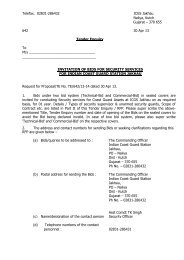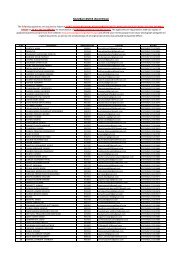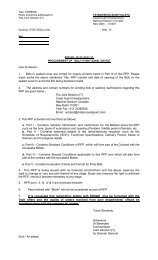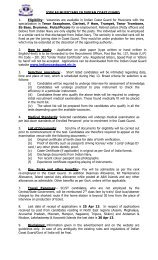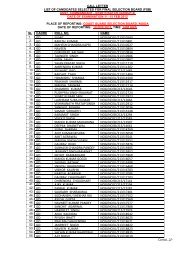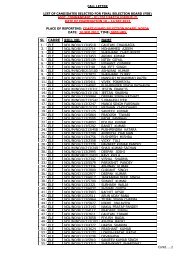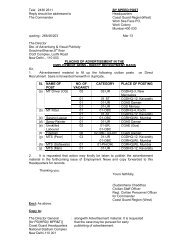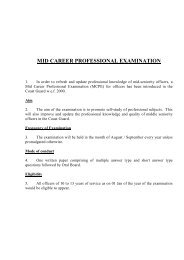eastern region oil spill disaster contingency plan - Indian Coast Guard
eastern region oil spill disaster contingency plan - Indian Coast Guard
eastern region oil spill disaster contingency plan - Indian Coast Guard
You also want an ePaper? Increase the reach of your titles
YUMPU automatically turns print PDFs into web optimized ePapers that Google loves.
- 9 -<br />
EASTERN REGION OIL SPILL DISASTER CONTINGENCY PLAN<br />
(EROS – DCP)<br />
Introduction<br />
1.1. The <strong>Indian</strong> Ocean is closed by landmass on the north, but towards the<br />
east and west, there are entries and exists through very narrow restricted water,<br />
namely, the Gulf of Aden and Straits of Malacca. Almost all ship- borne<br />
movements from east to west and vice versa must therefore transit across the<br />
<strong>Indian</strong> Ocean. As many as 200 ships pass through these waters every day,<br />
carrying over 90% of world trade, including <strong>oil</strong>. Further the economic status of<br />
India has been considerably enhanced with major <strong>oil</strong> exploration, production and<br />
refining facilities within the EEZ, making it highly desirable to cater for the<br />
<strong>contingency</strong> of major <strong>oil</strong> <strong>spill</strong> within the EEZ.<br />
1.2. The Eastern <strong>Coast</strong> supports a number of coral reefs, marine like.<br />
Mangroves forests and variety of fish on the <strong>eastern</strong> sea board which need to be<br />
protected against the detrimental effects of <strong>oil</strong> pollution. The coastal<br />
environment is a complex, sensitive and dynamic Eco-system, which demands an<br />
appropriate, compatibility and effective response in the event of an <strong>oil</strong> <strong>spill</strong>.<br />
Scope<br />
1.3. To combat an <strong>oil</strong> <strong>spill</strong> in the Bay of Bengal, it is desirable to co-ordinate<br />
pollution response activities amongst various government and non-government<br />
agencies. The <strong>contingency</strong> <strong>plan</strong> is intended to identify the capabilities and<br />
resources in order to establish an organizational structure to combat marine<br />
pollution, so that focal points and lead agencies are clearly identified for an<br />
appropriate and affect the pollution control response.<br />
1.4. The Eastern Regional Headquarters has been vested with the role and<br />
responsibility to prepare for combating a major <strong>oil</strong> <strong>spill</strong> up to 10,000 tonnes in<br />
her maritime area. Any requirement of combating a major <strong>oil</strong> <strong>spill</strong> above 10,000<br />
tonnes would be undertaken by consolidating all the available resources and<br />
equipment from other Regions.<br />
1.5. The EROS-DCP also provides the frame work for co-coordinated integrated<br />
response by various government agencies that are functionally responsible for<br />
monitoring, control and combating marine pollution by <strong>spill</strong>age of <strong>oil</strong> around their<br />
areas of operation. However, the <strong>Coast</strong> <strong>Guard</strong> shall remain as the Central Cocoordinating<br />
Authority in combating <strong>oil</strong> pollution during major <strong>oil</strong> <strong>spill</strong>s.




